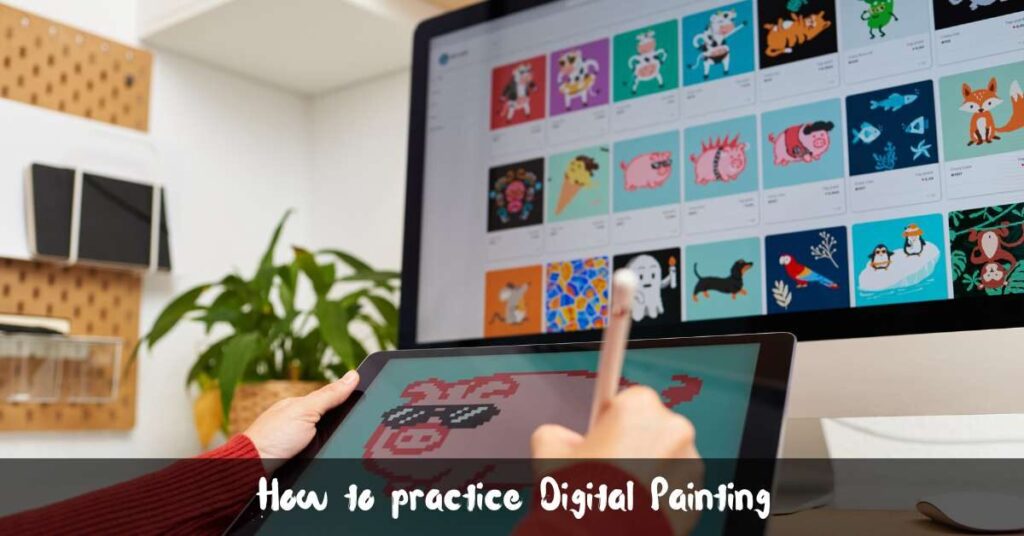Digital painting is an exciting and creative way to express your artistic vision using modern tools like tablets, styluses, and software such as Adobe Photoshop, Procreate, or Krita. Whether you’re transitioning from traditional painting or just starting out, learning how to practice digital painting effectively can help you improve faster and build your unique art style.
In this guide, we’ll walk you through step-by-step techniques, daily practice tips, tools you need, and beginner-friendly exercises to get you started on your digital art journey.
What is Digital Painting?
Digital painting is the process of creating artwork using digital tools instead of traditional mediums like canvas or paper. Artists use a stylus and drawing tablet (or an iPad with Apple Pencil) to paint directly into software that mimics brushes, colors, and textures.
Unlike traditional painting, digital art offers layers, undo/redo functions, easy color correction, and limitless customization, making it perfect for both beginners and professionals.
Tools You Need to Get Started
Before you begin practicing, here’s what you need:
- Drawing Tablet (like Wacom, Huion, XP-Pen, or iPad with Procreate)
- Stylus (pressure-sensitive for brush control)
- Painting Software (Photoshop, Krita, Procreate, Clip Studio Paint, etc.)
- Reference Images (real-world photos, art styles you admire, or poses)
- Basic Knowledge of Layers, Brushes, and Color Palettes
How to Practice Digital Painting: Step-by-Step Tips
1. Start with Basic Shapes and Sketching
Focus on drawing simple objects like spheres, cubes, and cones to understand form, light, and perspective. Then move to basic sketches using light strokes.
Practicing these fundamentals helps you understand volume and depth.
2. Understand How Layers Work
Layers are a game-changer in digital painting. Use separate layers for:
- Sketch
- Line Art
- Base Colors
- Shadows
- Highlights
This makes editing easier and teaches you to organize your workflow.
3. Practice Brush Control
Spend time exploring different brush settings:
- Hard and soft brushes
- Pressure sensitivity
- Opacity and flow
Try practicing smooth strokes, blending, and texture creation.
4. Study Color Theory and Lighting
Understanding how light interacts with objects, shadows, and color temperatures is essential.
Try painting the same object in different lighting – daylight, sunset, indoor – and observe how colors change.
5. Do Photo Studies and Master Studies
- Photo Studies: Choose a photograph and try to replicate it.
- Master Studies: Repaint artworks from famous digital artists or classical painters (for learning, not copying).
These exercises help you improve observation and painting accuracy.
6. Set Daily or Weekly Art Challenges
Try challenges like:
- 30-minute speed painting
- 100 heads challenge
- Color palette limitations
- One-layer painting
Consistency matters more than perfection.
7. Join Online Communities and Get Feedback
Platforms like ArtStation, DeviantArt, and Reddit (r/learnart) are great for feedback.
Don’t be afraid of criticism. Constructive feedback can supercharge your progress.
8. Keep a Digital Sketchbook
Maintain a daily digital sketchbook. It could include:
- Doodles
- Practice strokes
- Color blends
- Idea roughs
Over time, you’ll see how much you’ve grown.
Bonus: 3 Beginner Practice Exercises
- Grayscale Painting
Paint in grayscale to focus only on value and lighting, without the distraction of color. - Still Life Painting
Choose simple household items and paint them digitally. - Self-Portrait Challenge
Paint your own face from a mirror or selfie — great for learning anatomy and shading.


